|
OUR
HISTORY
|
| _ |
|
DOUGLAS C-124C GLOBEMASTER S/N 52-0994 |
|
|
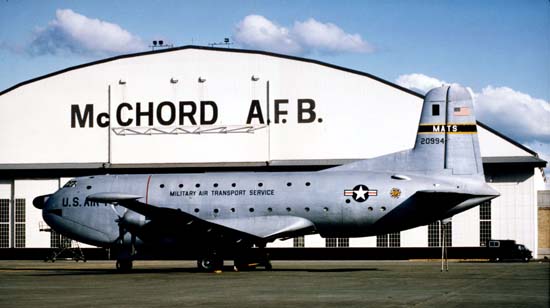 |
|
|
|
THE QUEST TO "BRING HOME" A DOUGLAS
C-124 AS SEEN THROUGH THE EYES OF CHUCK BOWEN
|
|
|
|
In February of
2013 one of the McChord air Museums founding members, MSgt. Chuck
Bowen (USAF Ret) put away his tools and retired for the last time at
McChord leaving the Museum after more than 30 years of loyal service
to the organization. Over his time with the Museum, Chuck was a part
of many projects, but the one he will be most remembered for will be
the C-124.
As a tribute to his Father, Gary Bowen authored this story covering
Chuck's military career and details of the successful mission that gave
McChord one of the last remaining C-124's
|
|
|
|
|
|
MASTERS OF THE AIR |
|
By Gary Bowen - McChord Air Museum Foundation |
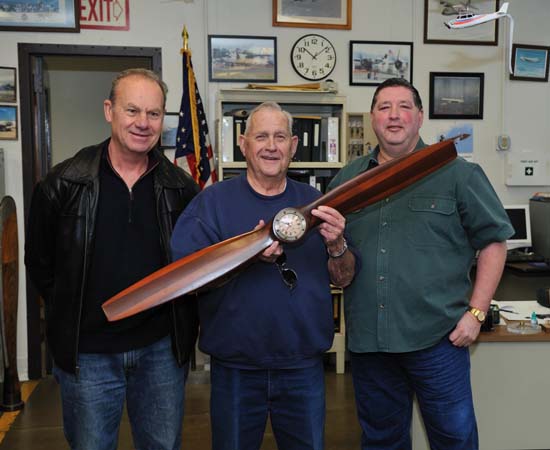 |
|
On his last day with the McChord Air
Museum, MSgt. Chuck Bowen (USAF Ret) is presented a propeller clock by
McChord Air Museum Foundation Vice President Randy Getz and McChord
Air Museum Administrator / Curator Ray Jordan.
|
|
|
|
You can
take the Master Sergeant out of the Air Force, but you can't take the Air
Force out of the Master Sergeant and, Master Sergeant Chuck Bowen was no
exception.
Chuck enlisted in the Air Force during the Korean War. He was 17 years
old, and had just lost his job because he had a broken collarbone. Chuck
was getting hungry, so he decided to go see the Navy recruiter.
Fortunately, for both Chuck, and the United States Air Force, the Navy
recruiter was out to lunch. The Air Force recruiter wasn't. In those days,
most USAF aircraft had propellers. Although he graciously worked on jets
occasionally, his love was, 'real airplanes with round engines.' Chuck
became the 'go-to' guy on round engines.
His Air Force career took him all around the world, even all over
Southeast Asia. Stuff he's
not allowed to talk about. His Air Force career even took Chuck into the
jet age. Still, as long as the USAF aircraft with round engines, Chuck was
the man they called.
In
1974, Chuck retired from the Air Force. His retirement allowed him to
enjoy life, even start a second career with the General Electric Company.
Naturally, they put a tool in his hand, and Chuck did what he does best.
Chuck even spent part of his retirement traveling with his family. When he
traveled, he usually traveled to where there was an air show. In his
retirement, Chuck even fulfilled a lifelong dream. He obtained a pilot
license. He was a proficient pilot, but continued to be an excellent
mechanic. Chuck even obtained his A & P license, and picked up his tools
again.
Chuck
continued to maintain close contacts on McChord Air Force Base. When news
spread that a museum was going to be opened on Base, Chuck was first in
line.
One of
Chuck's first duties as a museum volunteer was Gift Shop Manager. Chuck
assembled an inventory of affordable souvenirs. While operating the
souvenir counter at the museum building, Chuck would also serve as one of
the first docents and, on many weekends, Chuck would load up a trailer
with McChord Museum souvenirs, and open up an off-site concession stand at
any number of local air shows, 100% of the proceeds went into the museum
treasury.
In the
early days, the museum building was located on what is now Heritage Hill.
Museum visitors had only to step outside, and would have a grandstand view
of ramp traffic. It was not unusual for museum visitors to exchange waves
with F-15 and T-33 pilots from the 318th FIS, or C-141 crewmembers from
the 62d MAW.
When the new museum began assembling a collection of aircraft, Chuck again
did what he does best; he picked up his tools, and began working on museum
aircraft. It is likely that Chuck has had his tools on just about every
airframe in the current museum inventory. He's even done some work on the
pointy-nose jets that he still graciously tolerates.
The history of
McChord Field would not be complete without mention of a long-time McChord
staple, the mighty Douglas C-124 Globemaster. The McChord Museum inventory
would not be complete until one could be acquired in its collection.
That's exactly what Chuck and the other museum volunteers intended to do;
obtain a C-124.
|
|
|
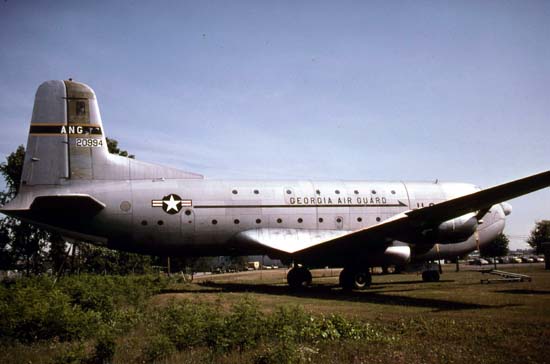 |
|
C-124C S/N 52-0994
at Detroit Institute of Aeronautics, Detroit Institute of Aeronautics,
1980. |
|
|
|
When the USAF retired the Globemaster, not many of them were kept. Most
were sent to, 'The Boneyard,' where they were promptly scrapped. After
all, this was the jet age, the C-124 was a hold-out from an earlier era.
With fewer than a dozen C-124s remaining, obtaining one for the museum was
not going to be easy. McChord Air Museum volunteers were mostly USAF
veterans used to doing what isn't easy. If there was a C-124 airframe
available anywhere, they were going to do what was necessary to get it
back to McChord. It would be a disservice to not mention the sacrifice and
expense the early museum volunteers endured to obtain the C-124. Although
one was located at a trade school in the Midwest, getting it to McChord
was not an easy task.
It took some serious
horse-trading simply to obtain ownership of this potential museum
flagship. After the lawyers
were consulted, a more suitable aircraft in the Air Force Museum inventory
was traded to the school, for their needs. The McChord Air Museum now had
a C-124, USAF tail # 52-0994. This particular aircraft was never assigned
to McChord, but it was the airplane they were looking for.
It took
some work to make -0994 flight-worthy. It had sat in the same place for so
long, that full-grown trees blocked it in. The engines had been run
regularly until the aircraft fuel tanks were depleted. Then, they just sat
and deteriorated to the point of being unusable.
Chuck and
his fellow volunteers made many trips to where the C-124 sat. They spent
their own funds for travel, and housing, and used their own tools to ready
-0994 for travel. Old USAF contacts were re-established, and needed parts
were obtained. The most difficult to find were four, usable Pratt &
Whitney 4360 engines. Finding and obtaining the engines was the easy part.
Chuck and his colleagues had to change all four engines out in the open.
Every inch of -0994 had to be inspected, and if necessary, repaired. After
all the work was done, every system on the airframe had to be tested prior
to inspection by the FAA. Finally, FAA had granted permission for a VFR
(Visual Flight Rules) ferry flight to McChord Air Force Base.
The flight
took place in October 1986, needless to say, the C-124 didn't arrive at
McChord unnoticed, it was escorted by a McChord C-141 and C-130. In true
C-124 fashion, one of the engines had to be shut down because of an oil
leak, and -0994 arrived at McChord with one engine smoking. It was rumored
that every fire department in Pierce County received reports of a large
airplane with one engine on fire. Nevertheless, -0994 arrived safely at
McChord with substantial fanfare. The McChord Fire Department did roll out
their crash trucks, but not because they feared, the C-124 was on fire.
They rolled out their trucks to give the arriving C-124 the honor of a
ceremonial master stream bath.
Ironically, despite all the work Chuck put into getting Old Shakey ready
for its flight to McChord, Chuck was not aboard for the flight. He gave up
his traditional post at the Flight Engineers panel to another "FE", he was
on-hand for the arrival though.
|
|
|
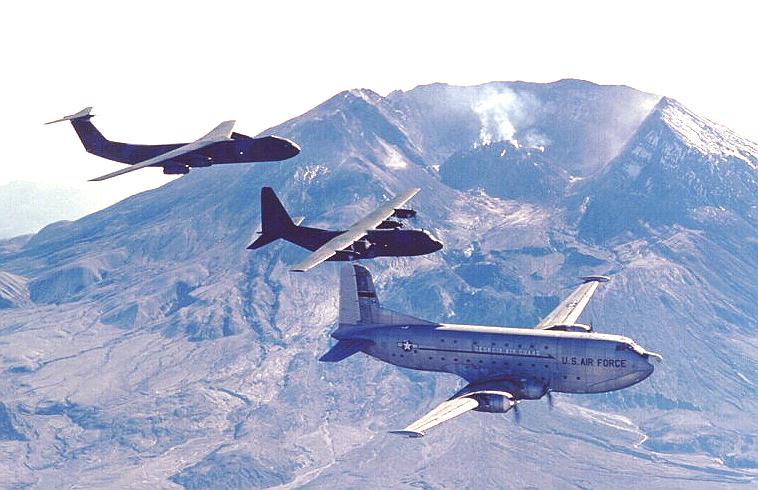 |
After months of hard
work by Air Force, Air Force Reserve and Museum Volunteers,
C-124C 52-0994 completed a nonstop flight from Selfridge ANGB
to its final destination at McChord AFB on October 9, 1986.
The delivery of -0994 to the McChord Air Museum, pictured
here with 62d MAW C-141 & C-130 over Mt Saint Helens, was the
last flight ever of a C-124 Globemaster II.
|
|
|
|
Now that
-0994 was part of the McChord Air Museum inventory, the work was just
beginning. Fortunately, McChord still had a large pool of veterans
familiar with the C-124. They banded together at least one Saturday per
month, for a C-124 work party. Soon, the work parties became more
frequent. There was lots of work to be done on the C-124. The more work
they did, the more things they discovered needed to be done. Most of the
equipment at McChord was built to support the current mission aircraft,
the C-141 StarLifter. Even getting a stand tall enough to paint a prop
line on the aircraft was a challenge.
A rappel rope worked in this case. A 'cherry picker' boom truck
would need to be brought in if any work had to be done on the 48' vertical
stabilizer.
In those
days, climbing on the roof of the fuselage, or working on top of the wings
without a safety line, were not unusual.
Usually,
the workday would culminate at Maxie's, a local restaurant that served
creamed chipped beef on toast. The S.O.S. was tasty if you're a USAF
veteran, but the better part of the after-work meal was the sharing of
C-124 experiences.
The C-124
was stationed on the ramp, in several different areas over the years. Ramp
access was attained with little difficulty in those days. During work
party days, it was not unusual to be visited by members of the 62nd
Security Police. They would begin by investigating the open clamshell
cargo doors, but would usually finish by receiving a guided tour from a
proud volunteer. Chuck had no reservations about parking his distinctive
pick-up truck right under the wing of -0994. It was identified by the
custom license plates sporting, 'CHUXTRK.' The Security Police became
familiar with 'CHUXTRK'.
Chuck served as Crew Chief of the C-124, and eventually 0994 began to
clean up well. The first paint job was financed and completed by museum
volunteers, under the supervision of Chuck. Once she was presentable, they
began to be invited to many parties.
The museum
C-124 was the site of many retirement and re-enlistment ceremonies. Chuck
and the C-124 crew staffed the aircraft for every McChord Air Show. The
clamshell cargo doors would be opened wide, ramps brought down, and safety
stantions inserted. Because of the diligence of Chuck and the dedicated
C-124 crew, literally tens of thousands of visitors got a brief glimpse of
what the Air Force was before all those shiny, ultra-modern jets. The
aircraft and crew attained a safety record seldom achieved by any display
aircraft.
|
|
|
%20550X365.jpg) |
|
Chuck stands at the head of the line
of the McChord Air Museums C-124 Crew, the junior member of the crew,
Chuck's son Gary stands in the middle.
|
|
|
|
In 1991, Chuck even recruited a specific crew member, his son Gary. I had
served as an occasional volunteer previously, when they needed a tunnel
rat to get into tight spaces on the aircraft.
Now however, I was an official member of the crew, the only
father-son volunteer team on the McChord Museum staff. 'Chucks Kid', as he
was known, was frequently seen walking a respectful step behind Chuck. Or
not. I continue to volunteer with the museum, in several different
capacities.
When the
MAC Rodeo was held at McChord in 1994, a new visitor was to be featured,
the C-17 Globemaster III. The 62nd Wing Commander, General 'Buck' Marr
decided that the C-124 Globemaster II was to be the Rodeo Centerpiece. The
theme was to be Globemaster II meets Globemaster III. With the assistance
of General Marr, the exterior paint on the C-124 was given a touch-up. The
interior was given a total Hollywood-type makeover. General Marr brought
in a crew that completely rebuilt the interior of the cargo deck,
fluorescent mood lighting was temporarily installed, a carpet covered the
cargo deck, and cocktail tables were brought in. The airstairs on both
man-doors on either side of the fuselage, completed the transformation of
-0994 from a C-124, into a VC-124 as Chuck called it.
That year,
0994 was host to many USAF dignitaries, including Secretary of the Air
Force, Sheila Widnall. Several Medal of Honor recipients were kind enough
to visit during the 1994 Rodeo also, as well as representatives of air
forces throughout the world, -0994 was the most photographed aircraft of
the 1994 MAC Rodeo. Since then, 0994 has been converted to a more
traditional configuration, but has dressed up for other dignitaries on
occasion.
|
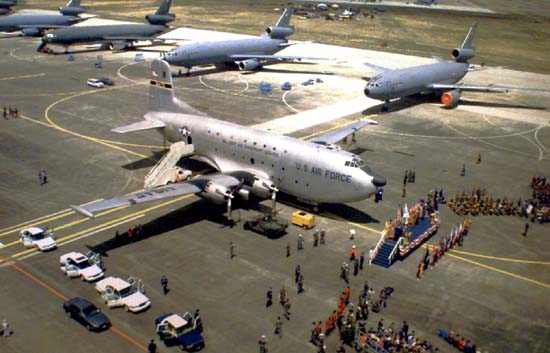 |
|
Chuck's C-124 made a great backdrop for the main stage during
McChord's first Airlift Rodeo in 1994.
|
|
|
|
Not long
after the Rodeo, 0994 was host to another celebrity; James Doohan, better
known as Federation Engineering Officer Montgomery Scott from the USS
Starship Enterprise. As a retired Flight Engineer, Chuck had lots in
common with Engineering Officer Scotty. They were both gracious enough to
pose together for several photographs around the Engineers Console on the
C-124. Sadly, James Doohan is no longer with us, but memories of his visit
will never be forgotten.
In between
the yearly air shows, and MAC or AMC Rodeos, Chuck and his crew would open
up the C-124 for literally dozens of groups of visitors. Everybody from
Cub Scouts to Tuskegee Airman got a glimpse of how the USAF was in earlier
days.
In 1999,
McChord received the first of its newest mission aircraft, the now-Boeing
C-17, naturally -0994, Chuck and his crew were invited to the party. With
this assignment -0994 was again converted to its VC-124 configuration.
Visitors comparing the new Globemaster next to the vintage Globemaster
could only marvel at the difference in technology.
|
|
|
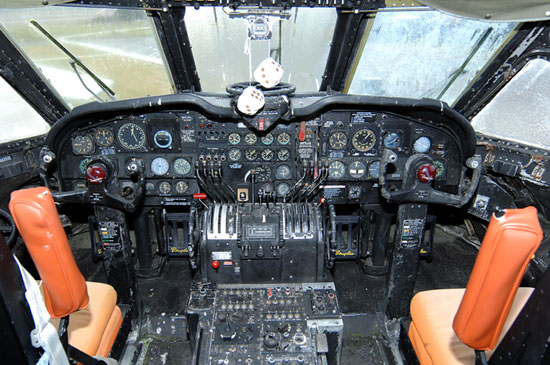 |
|
A
sight that will not be seen in the future, the 50's era fuzzy dice
hanging in the cockpit of C-124 -0994. After inspections deemed this
area and other areas of the aircraft unsafe, due to aged
instruments leaking low levels of radiation, which have since been
removed. The cockpit has been
permanently
closed.
|
|
|
|
On September 11, 2001, McChord Air Force Base, and the world changed
drastically. Not only was ramp access severely limited, but also was base
access itself. Civilian visitors had a difficult time getting to the
museum, and as a result, the numbers dropped drastically. America, and
McChord was at war, and tight security was necessary. The tight security
did severely hinder access to the C-124, which was still stationed on the
ramp. Chuck and his crew had a nearly impossible task of getting to the
aircraft to perform necessary maintenance. On an airframe that size, and
vintage, deterioration and corrosion was inevitable without constant
attention. Because of the size of -0994, moving her to the museum airpark
was not possible. She remained locked out on the ramp with her partner, a
Lockheed C-141 StarLifter.
To improve
access for crew and visitors, Chuck was agreeable to the proposal of
relocating the C-124 to Heritage Hill, overlooking the runway ironically,
very near to the site of the original McChord Air Museum building. After
another fresh coat of paint, courtesy of the Base's Corrosion Control
Crew, -0994 was moved to, 'the Hill,' on a very cold January 4, 2005.
Chuck was on-hand to monitor the move.
This airplane was his personal responsibility since even before she
came to McChord, and very few active duty USAF personnel have experience
towing the C-124.
|
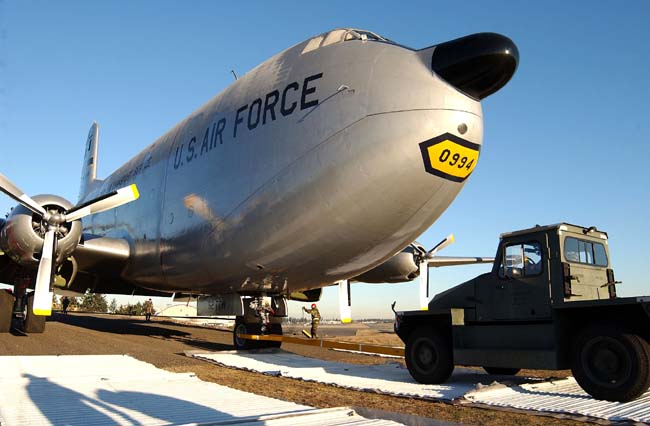 |
|
On
a cold January morning in 2005 members of the 62d Maintenance Squadron
and McChord Air Museum tow C-124 -0994 to its new home on Heritage
Hill. For additional photos visit the
"Move to the Hill" page.
|
|
|
|
Thankfully, the ground was frozen solid enough to support the C-124, and
the airplane was moved without incident, the move took a toll however.
Later that month, Chuck entered Tacoma General Hospital for a
cardiac bypass, it was rumored that the move, and the bypass were related.
Chuck recovered from the bypass without complications, and resumed his
role as C-124 Crew Chief. With access to the airframe, restoration work
resumed. On Heritage Hill, -0994 continued to host air shows, and AMC
Rodeo events. Eventually, all the museum aircraft were relocated to the
hill. The Rodeo evening events would often center around the Museum
aircraft. Tent City was erected for every Rodeo, and literally surrounded
the museum aircraft collection.
In 2009,
the C-124 hosted its last AMC Rodeo. USAF officials decided that the
radium instruments on the flight deck presented a radiation hazard to the
crew and visitors. The flight deck was completely declared, 'off limits,'
and access to the rest of the airframe was severely limited. At subsequent
air shows, and rodeos, countless visitors would continue to ask when the
C-124 would be opened up for visitors. Sadly, they would be disappointed.
|
|
|
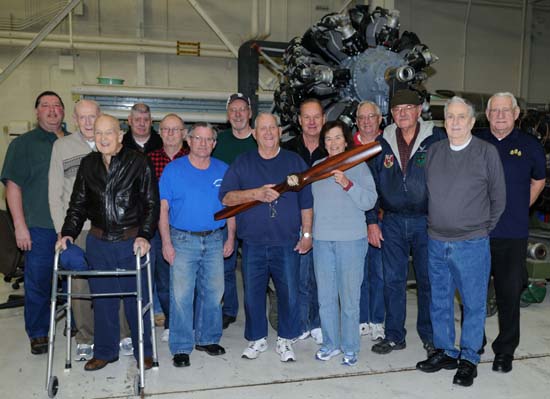 |
|
With is retirement propeller in hand, Chuck stands with his crew on
his last day as "Hangar Boss" at the Museums Restoration Hangar.
|
|
|
|
With access to his beloved C-124 restricted, Chuck spent his days at the
museum restoration hangar. The interior to the C-124 was closed, but there
were still plenty of aircraft that needed his experience and expertise. He
and his hangar colleagues would meet over coffee in the morning, and plan
their strategy for the day. Chuck would serve as liaison between hangar
volunteers, and the museum administration, and this arrangement keeps the
restoration efforts coordinated and smooth.
Also, many
of the original C-124 crew members eventually succumbed to old age, and
duty-related medical conditions. With their passing, valuable experience
and knowledge was lost forever. Chuck even lost his favorite C-124
volunteer in 2003, his beloved wife, Charlene. She was faithfully at his
side at many air shows since the C-124 first arrived. They had been
married almost 50 years.
Recently,
Chuck surprised everybody with a lightning bolt that could only come from
Chuck. While returning from a
squadron reunion, he met a pleasant widow named Doris. It didn't take long
for them to decide they wanted to spend the rest of their lives together.
They would not be remaining in Washington. It would be necessary for Chuck
to retire from serving McChord.
He arrived
at McChord Air Force Base as a young Staff Sergeant in 1964. He remained
in the area after his retirement in 1974 as a mature Master Sergeant. He
immediately began to serve at the McChord Air Museum, and after 49 years
of serving, retired from JBLM McChord Field. He had gone from an era of
piston-engine propeller aircraft, to fly-by-wire, ultra-modern jet
aircraft.
Chuck left
McChord better than he had found it. His legacy will be remembered every
time somebody looks at his C-124. Godspeed Chuck Bowen, and good luck. May
you enjoy every minute of
this next chapter of your life.
|
|
|
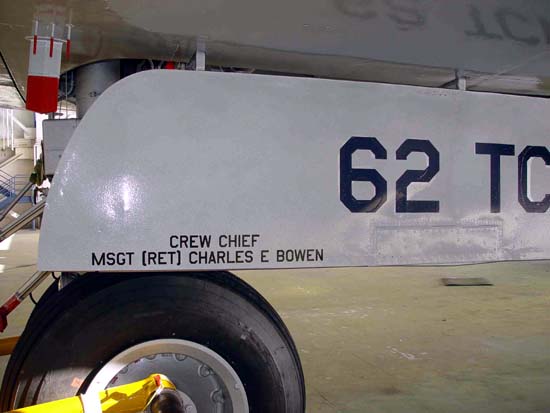 |
|
|
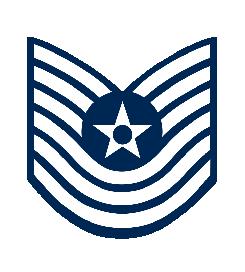 |
|
|
|
|
Website
provided and maintained by: |
|
|
| The
McChord Air Museum Foundation |
|
P.O.
Box 4205 |
|
McChord
AFB, WA. 98438-0205 |
|
253-982-2485 |
|
e-mail
- mamfound@mcchordairmuseum.org |
|
|
| |

|
| |
| |
|